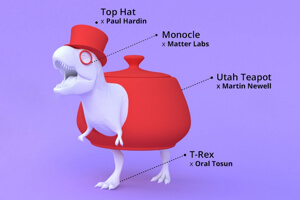Matter.io Wants to Make 3D Modeling Easy as Instagram
3D printing is increasingly an essential part of industrial processes. But for those lacking digital design experience and who aren’t daily fabricating rocket motors or bike parts—essential isn’t quite the word. MIT Media Lab’s Matter.io is on a mission to lure in the masses with user-friendly design software; software that vastly simplifies 3D modeling.

Share
3D printing is increasingly an essential part of industrial processes, but for those lacking digital design experience and who aren’t daily fabricating rocket motors or bike parts—essential isn’t quite the word.
Matter.i0, a startup connected to MIT's Media Lab, is on a mission to lure more folks into 3D printing by providing user-friendly design software - software that vastly simplifies 3D modeling.
“We're trying to bring Instagram-like ease to 3D modeling, democratizing 3D content creation for all by making custom objects as easy to make as applying a photofilter," Matter.io founder, Dylan Reid, told 3Ders.org.
To that end, the startup launched a beta version of a 3D modeling program called Matter Remix last fall. After starting the software in their browsers, users can choose from a library of existing models—mixing, matching, resizing, chopping, and generally remixing the various designs to create something new.
Users might pull up a 3D model of a t-rex, a teapot, and a top hat, each designed by a different artist. They can change the color of the top hat, play with its proportions, apply a variety of textural filters, set the “remixed” top hat atop the t-rex and both inside the teapot—then order a 3D printed copy for delivery.
Matter.io isn’t the first to simplify 3D modeling. Autodesk's free 123D suite of browser-based 3D modeling software is simpler than CAD, the firm's professional 3D modeling program, but it still takes exploration and practice.
Reid says even with an earlier iteration of their software, folks unfamiliar with 3D modeling and unused to “thinking spatially” would mistakenly think certain unattached components were attached, when they just needed to rotate the model. Sometime they’d only design half an object or make things that couldn’t be printed.
According to Reid, although folks say they want to design products, that’s not strictly true in practice. They don’t really want to get into the nitty gritty; they just want to play a role in the design process in the “broadest sense.”
The first site to use Matter.io’s 3D modeling platform is called Dyo.
Be Part of the Future
Sign up to receive top stories about groundbreaking technologies and visionary thinkers from SingularityHub.


The targeted audience is somewhere between lay people and professional engineers and digital designers. The site allows independent artisans and designers to make their products customizable and 3D printable—something that wouldn't be easily accomplished without significant technical expertise.
Dyo is a marketplace of independently designed jewelry (like Etsy), but everything is 3D printed and customizable. If, for example, you want to buy your sweetheart a ring, you browse the selection, choose a ring and material (bronze or silver), enter a custom message to be printed on the ring, and send it to Shapeways for printing.
It's a great concept, if not terribly exciting in practice yet. A simple 3D printed ring or pendant (as opposed to some twisted, mathematically impossible shape) doesn’t play to the technology’s natural advantages. Further, the personalization is too limited, and the cost of a ring, for example, no cheaper than a traditional, engraved silver band.
Even so, Dyo is just the first site using the platform. It’s very new and all the designs appear to be by the founders.
Presumably, as designers learn to use it to showcase their work, the selection of cool stuff and custom options will expand. And really, it’s the bigger picture that matters.
Beyond brief bouts of excitement reading tech news articles, 3D printing won't prove essential to the masses until it's more intuitive and useful. Matter.io's philosophy of "simplify, simplify" is a step towards the former and making the tech available to less technically inclined designers ought to bring a new group into the fold.
Image Credit: Shapeways/Flickr; Matter.io; Madeline Gannon/Flickr
Jason is editorial director at SingularityHub. He researched and wrote about finance and economics before moving on to science and technology. He's curious about pretty much everything, but especially loves learning about and sharing big ideas and advances in artificial intelligence, computing, robotics, biotech, neuroscience, and space.
Related Articles

How Scientists Are Growing Computers From Human Brain Cells—and Why They Want to Keep Doing It

These Brain Implants Are Smaller Than Cells and Can Be Injected Into Veins

This Wireless Brain Implant Is Smaller Than a Grain of Salt
What we’re reading



